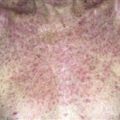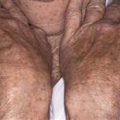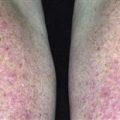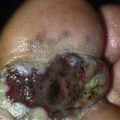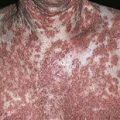41
Grover disease (transient
acantholytic dermatosis)
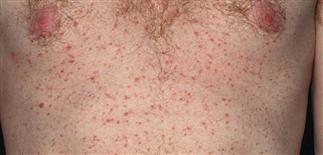
The chest and upper abdomen is the most common site. Lesions may appear on the upper back, shoulders, and proximal extremities.
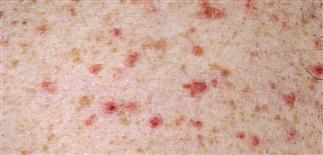
Discrete red-brown itchy papules are the common presentation. Occasionally, lesions are vesicular or pustular.
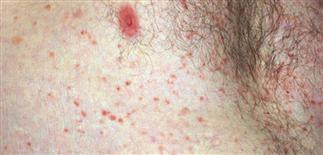
Grover disease may cover wide areas of the chest and abdomen. Itching is typical but not a constant feature.
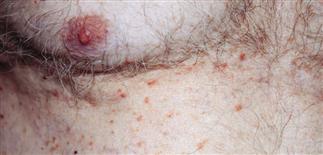
Lesions resolve with postinflammatory hyperpigmentation or hypopigmentation.
DESCRIPTION
Uncommon, papular, itchy disorder of the chest and abdomen of unknown etiology. May persist for months and years.
HISTORY
• Self-limited. • More common in white, middle-aged men. • Itching is intermittent, mild to severe, exacerbated by heat or sweating.
PHYSICAL FINDINGS
• Chest, lower rib cage, upper back, lumbar areas. • Red-brown, keratotic papules that are often excoriated. • May spread to lateral neck, shoulders, upper thighs. • Older patients will usually have longer-lasting, more extensive eruptions.. • Lesions resolve with postinflammatory hyperpigmentation or hypopigmentation. • Biopsy may be required for diagnosis.
TREATMENT
Itching is mild in some cases, and symptomatic relief with mentholated lotions (Sarna) is all that is necessary. Colloidal oatmeal baths may relieve itching. Avoid strenuous exercise, excessive bathing, and exposure to heat. • Group II–V topical steroids: moderately effective, used as needed. • Oral vitamin A: 50 000 international units t.i.d. for 2 weeks then reduced to 50 000 international units q.d. for a maximum of 12 weeks may be effective for extensive and severely pruritic cases. • Isotretinoin: 40 mg q.d. until controlled (2–12 weeks), then taper dosage to 10 mg q.d. once patient improves and continue for 12 weeks. • Prednisone: 20 mg b.i.d. controls extensive inflammation and itching; relapse after stopping is common. • Antihistamines, oral antibiotics, dapsone: not effective.

